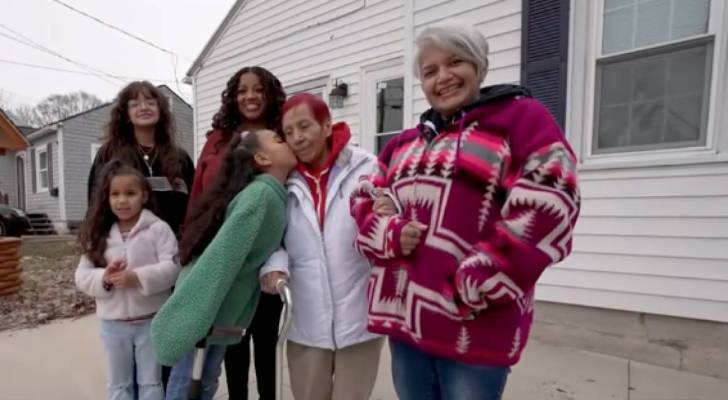
Four generations under one roof might sound chaotic, but for this family, it’s become the key to saving money and staying connected in a time of rising costs.
In Grand Rapids, Michigan, the Lowe family is proving that living together isn’t just about togetherness, it’s also a smart financial move.
Don’t miss
- I’m 49 years old and have nothing saved for retirement — what should I do? Don’t panic. Here are 5 of the easiest ways you can catch up (and fast)
- Thanks to Jeff Bezos, you can now become a landlord for as little as $100 — and no, you don’t have to deal with tenants or fix freezers. Here’s how
- Gain potential quarterly income through this $1B private real estate fund — even if you’re not a millionaire. Here’s how to get started with as little as $10
It’s a full house — and a growing trend. According to Pew Research, 18% of Americans now live in multigenerational households, a number that’s been climbing as rent and mortgage prices soar.
For the Lowes, this setup isn’t just practical, it’s necessary. With U.S. rent averaging over $1,700 a month and the median mortgage payments Americans are applying for reaching $2,205, sharing housing is helping them all stretch their dollars.
The pros outweigh the cons
Gema Lowe shares her home with her 84-year-old mother, her daughter Jade and Jade’s three kids.
"I’m blessed to be able to have my mom with me, my daughters with me and my grandbabies with me," Lowe told Good Morning America.
Jade, 29, pays her mom a portion of the rent instead of footing an entire mortgage on her own. The rest of the family chips in to split utilities, groceries and other expenses.
"It allowed me to still live my best life in my 20s,” Jade told GMA. “It allowed me to honestly just be happy and not have to worry about those extra expenses. I get to keep it, and I get to put it in my savings. It means everything, honestly."
The benefits go beyond just financial advantages. Gema helps with school pickups and childcare, giving Jade the kind of backup most working parents dream of.
Of course, sharing a home with six people of different ages can come with challenges.
"There’s a lot going on in the household. And sometimes, you know, I want things my way," Lowe said. "And then… I have to think about, ‘Oh, but maybe it’s not what they would like.’”
But according to the Lowes, the pros outweigh the cons. Family dinners are the norm, the kids grow up surrounded by love and wisdom from every generation and everyone saves on rent, childcare, food and even emotional labor.
Read more: Want an extra $1,300,000 when you retire? Dave Ramsey says this 7-step plan ‘works every single time’ to kill debt, get rich in America — and that ‘anyone’ can do it
It’s not just about saving
As housing costs soar and inflation stretches budgets, more Americans are turning to shared living across generations as a smart financial move.
According to the U.S. Census Bureau, about 6 million households in the U.S. included three or more generations living under one roof in 2020, up from 5.1 million 10 years prior.
Why? The answer’s simple: money.
In a 2021 Pew Research survey, half of lower-income adults said they chose this setup to ease at least a little bit of financial pressure. Even for middle- and upper-income families, multigenerational living can offer savings on everything from rent and mortgage payments to groceries and utilities.
Americans in these households are slightly less likely to live in poverty, with only 10% still considered poor versus 12% for the general population.
But it’s not just about pinching pennies. Shared living can often include other big perks. Think built-in child care, elder care and emotional support. Grandparents help with school pickups, parents share bills, kids grow up surrounded by extended family and everyone benefits from a little extra help.
Of course, it’s not always smooth sailing. Space can get tight and disagreements happen. If you’re considering sharing living space with your extended family, set clear expectations, communicate often and remember the bigger picture.
As Jade Lowe told GMA, “It’s a blessing to be able to still live at home with my mom, to be able to see my grandma on a day to day [basis], to be able to put my kids and my grandma under one roof where they have such a great relationship."
What to read next
- Don’t have the cash to pay Uncle Sam in 2025? You may already be eligible for a ‘streamlined’ handshake with the IRS — here’s how it works and how it can potentially save you thousands
- Here are 5 ‘must have’ items that Americans (almost) always overpay for — and very quickly regret. How many are hurting you?
- Robert Kiyosaki warns of a ‘Greater Depression’ coming to the US — with millions of Americans going poor. But he says these 2 ‘easy-money’ assets will bring in great wealth. How to get in now
This article provides information only and should not be construed as advice. It is provided without warranty of any kind.